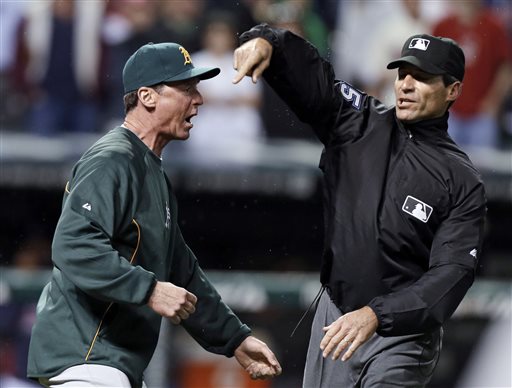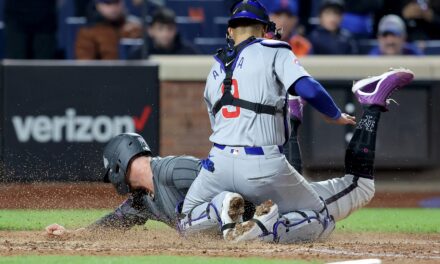
Baseball is an art form to some, but to pretty much everybody, when you chisel out the emotional elements (if you can bear it), it’s a game. And like every game, its integrity deserves to be respected and preserved by whatever means necessary.
Sometimes, these measures come at the expense of fans. One of the most thrilling, underrated aspects of the Mets’ 1969 World Series victory had to be the scene that proceeded Cleon Jones putting away the final out. It’s a shame to know fans will never be able to storm the field and create a euphoric moment for themselves, but in just about every other way imaginable, it’s for the best.
In a similar vein, the image of a red-faced manager holding back a disgruntled player as he tears into an umpire while tens of thousands of fans scream and toss their own profanities into the ring is one to behold. The visceral, unhinged anger directed towards authority – often frowned upon in our everyday world – is applauded on a baseball field, for better or worse. Human error and the subsequent eruption does more for baseball than many would be willing to give it credit for.
But at this stage in its history, it’s perspective that baseball so direly needs. It’s the commissioner actually having the gumption to try marketing the game’s best player successfully. It’s teams breaking personnel news after the involved players have received all necessary information. As we become more commercially invested, we run the risk of leaving the men on the field behind to play a separate game.
Needless to say, when Ben Zobrist is ejected from a game and fined for asserting to a home plate umpire that discussions of electronic strike zones are rightfully picking up steam, Major League Baseball very bluntly takes a side at the expense of its most important components, even if they don’t say much directly.
The only people who deserve a say in how Major League Baseball should be played are, well, Major League Baseball players. And after losing a crucial game following three consecutive strike calls that arguably shouldn’t have been, the Colorado Rockies had plenty to say to Kyle Newman of the Denver Post.
“You can’t rule out the emotional human factor of umpiring games, like when you make a borderline pitch a little off of the black that the robotic strike zone wouldn’t call a strike but the umpire could give you,” Chad Bettis told Newman. “Or, if you pitch to the glove, pitches spotted up just on the edge of the plate. That’s where it gets questionable, because that’s generally considered a strike, even by hitters.”
Premier reliever Adam Ottavino had a more calculated, but ultimately sensible approach to how he’d like his pitches called:
“Even if you are the best ump in the world and you are getting 92 percent of the calls right, that means if you have 200 pitches, there are 16 wrong… Those could be hugely impactful on the outcome of the game.”
There are certain facets of the traditional strike zone that may never truly be understood and taken into consideration by a machine. The archetypal pitcher’s pitch (something that cuts or floats its way around a hitter but winds up over the plate by the time the catcher has a glove on it), the check-swing (and the process of getting a ruling/asking for help), and the circumstances presented by the count itself (get-me-over versus too-close-to-take pitches) are just a few critical components in an umpire’s judgment of a strike zone that may never be fully replicated by an automated umpire behind the plate.
This isn’t to say home plate umpires have the current paradigm down pat. The outrage, in particular, has come to a boil over the last few years. Games are meant to be played against other people, and as a result, become significantly less rewarding when played against the circumstances themselves. No players would have to worry about Angel Hernandez ejecting them if the preposterous low-strike call was orchestrated by a machine. But perhaps there can be a middle ground.
As catcher Chris Iannetta put it in his discussion with Newman, “The game is based on subjectivity — it’s part of the game, and it provides an entertainment factor, even though it can be frustrating if it doesn’t go your way. It’s a different layer and element to the game.”
There’s certainly no reason – at least not with the current mechanical framework we know of – to assume an automated zone will rightfully reward a pitcher who hits his spot in a 3-2 count. Even if there were, the subjective element that Bettis and Iannetta hark back to is something players shouldn’t be deprived of if they would rather hold onto it.
In the meantime, an economical, sensible, and perhaps overdue decision that Rob Manfred could sign off would involve better representing disgruntled players while holding particularly shoddy and/or short-tempered umpires accountable. Umpires are well within their rights to protest what they see as “verbal attacks,” but players are all taught from a young age that arguing balls and strikes breaks one of the most sacred unwritten rules of baseball. Moreover, fans always remember and bemoan a player’s struggles with a vitriol that umpires will rarely fall victim to. Put another way, the player will always have the harder job, and unless his name is Milton Bradley or John Lackey, he usually makes a point worth noting.
Granted, Ottavino’s point of view cannot fall on deaf ears, and while Major League Baseball can, it should definitely use its available resources to try fine-tuning the prototypical “robot ump” however they can, bearing in mind the aforementioned intangibles that better define a strike than a simple assessment of whether or not a ball hovers over home plate. Human error shouldn’t have any hand in the end result, but also should be toyed with as players may grow even more restless with the current state of affairs behind home plate.
Innovation isn’t always welcomed, and for good reason. However helpful launch angles, exit velocities, and sabermetrics may be to those upstairs, the fact remains that players often feel marginalized by even the daintiest of numbers held over their heads. It’s difficult to succeed under such an intense microscope, and while they all sign up to do it, the players’ efforts in entertaining us certainly deserve to be met halfway.
To strip a fan’s entertainment away from baseball with a faulty yet “indisputable” automated strike zone would be a more criminal insult to our technological faculties than the Apple Pencil. Going digital for the sake of going digital would be an unfortunate, alienating, and indisputably strike-inducing maneuver that Rob Manfred and his current regime can ill afford. And for that reason, I’m currently against implementing an automated strike zone – at least while we have infallibly subjective and entertaining elements of our game worth protecting and enjoying.
While there’s still a forum for discussion, however, there are hundreds of active players with ideas worth taking into account. And the wisest decision on hand would be to hear them out and decide what traditions are really worth holding onto. The sport will certainly die out if those who play it – at the highest level, no less – don’t feel like the sport is giving something back to them. Speaking literally… this isn’t rocket science.















